| Article ID | Journal | Published Year | Pages | File Type |
|---|---|---|---|---|
| 7889777 | Composites Part A: Applied Science and Manufacturing | 2018 | 44 Pages |
Abstract
The current work studies the fatigue damage initiation and progression in a quasi-unidirectional non-crimp fabric based fibre composite used for wind turbine blades. This is done by combining in situ transilluminated white light imagining (TWLI) with ex-situ X-ray computed tomography (CT) experiments along with tension clamp X-ray CT experiments. TWLI is used to monitor the off-axis cracks in the thin supporting backing fibre bundles present in quasi-UD composites, and a crack counting algorithm is applied to automatically count the cracks in images obtained in situ during fatigue testing. It is found that off-axis cracks not only initiate at the specimen edges but also at isolated locations inside the specimen, which could be related to the microstructural features. In addition, a clear effect of strain level on the measured off-axis crack density is observed. From the X-ray CT experiments, it is found that the UD fibre fractures initiate and progress from regions where the off-axis backing fibre bundles are 'in contact' with a UD fibre bundle. Damage is seen to first initiate at a cross-over region of the backing fibre bundles, and later at a region with only one backing fibre bundle. In addition, applying tension to the specimen during X-ray CT scanning is found to reveal additional UD fibre fractures that are not visible in scans performed the unloaded state. With load applied, a significant number of UD fibre fractures were observed earlier in the fatigue life than expected. Based on the observations of the study a damage progression scheme is presented for quasi-UD fibre composites.
Related Topics
Physical Sciences and Engineering
Materials Science
Ceramics and Composites
Authors
Kristine M. Jespersen, Jens A. Glud, Jens Zangenberg, Atsushi Hosoi, Hiroyuki Kawada, Lars P. Mikkelsen,
